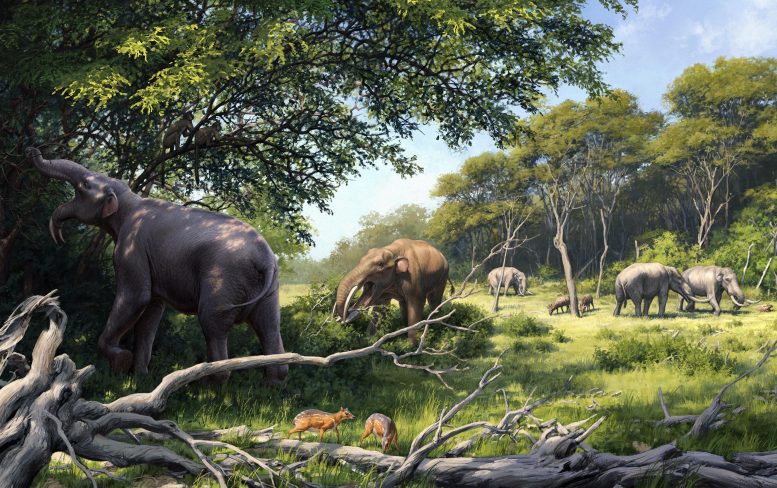
Before the evolution of modern elephants, their early relatives included several species that often shared their environment and adapted to feeding on different plants. This image depicts a landscape in Kenya in the Middle Miocene (about 15 million years ago), where a deinotheriid proboscidean (Prodeinotherium hobleyi, on the left foreground) and a shovel-tusked amebelodontid proboscidean (Protanancus macinnesi, behind Prodeinotherium) were feeding on leaves and branches from trees and shrubs, whereas a choerolophodont Afrochoerodon kisumuensis (in the background) fed on grasses in the locally open and grass-rich parts of the environment. They shared their environment with other herbivorous mammals such as chevrotains (Dorcatherium, left foreground), Victoriapithecus -monkeys (on the branches of the tree on the left) and early antelopes (Homoiodorcas/Turcocerus, in the background). Credit: Beth Zaiken
Recent research indicates that the molar teeth of proboscideans, which include elephants and their prehistoric kin, adapted due to shifts in diet brought about by vegetation and climatic changes in East Africa during the last 26 million years.
Recent research from the University of Helsinki on proboscideans, which includes elephants and their ancient relatives, presents evidence indicating that some of these creatures began adapting to grass-rich environments in East Africa. This adaptation was initiated by a change in their behavior, notably an increased reliance on feeding on grasses. The study reveals that such changes occurred in certain proboscidean lineages, such as choerolophodonts, much earlier than previously believed, specifically between 23 to 11 million years ago in regions of East Africa.
Furthermore, the study notes that approximately 7 million years ago in the Lake Turkana region, increasingly grass-rich diets of the earliest true elephants were associated with dryer and more grass-rich savanna environments than elsewhere in East Africa.
“This supports the hypothesis of such regions as “species-factories” where evolutionary adaptation to changing environmental conditions first centered around”, says Juha Saarinen from the University of Helsinki, who led the research.
Feeding on grasses is more demanding on teeth than feeding on most other kinds of plants due to a high content of mineral grains called phytoliths in their leaves, causing heavy abrasion on teeth.
Nonetheless, during the Early and Middle Miocene, the choerolophodont lineage of proboscideans were able to shift to more grass-rich diets with relatively modest changes in the morphology of their teeth.
Since about 10 million years ago, major changes in climate had a more profound effect on the evolution of proboscidean teeth in East Africa, especially the evolution of true elephants (Elephantidae) with highly specialized high-crowned, multi-ridged molar teeth.
“We were able to show that the strongest peaks of drying of the East African climate during the last 7 million years (for example about 4 and 2 million years ago) correspond with evolutionary bursts in the increase of tooth crown height and the number of ridges on the molar teeth, while these evolutionary changes did not reverse during periods of less harsh climatic conditions,” says Saarinen.
“This supports earlier suggestions that adaptive traits in organisms are adaptations to extreme rather than average environmental conditions.”
Comparing evidence of past vegetation and the diet of elephants during the last 7 million years also showed an increase in grasslands and increasing dominance of grass-feeding elephants with highly specialized teeth throughout that period in most parts of East Africa. However, during the last 100 000 years, this situation changed probably because of drastic fluctuations in global climate and eventually only the dietarily more generalist modern African savanna elephant (Loxodonta africana) with less specialized teeth survived in East Africa. Ecological generalism might similarly explain the survival of Asian elephant (Elephas maximus) in Asia, while the African forest elephant (L. cyclotis) was able to find refuge in more forested parts of Central and Western Africa.
“The ecologically quite versatile modern elephants were the sole survivors of the tumultuous climate changes of the late Pleistocene. Now it’s us humans that threaten the last surviving species of this ecologically important group of animals, and we should work hard to keep them from being lost forever.”
Reference: “Fluctuating climate and dietary innovation drove ratcheted evolution of proboscidean dental traits” by Juha Saarinen and Adrian M. Lister, 14 August 2023, Nature Ecology & Evolution.
DOI: 10.1038/s41559-023-02151-4


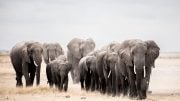

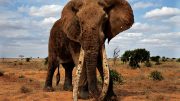


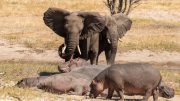
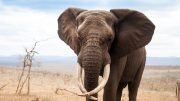
Be the first to comment on "The Ancient Dietary Secrets of Elephants: A Tale of Evolution and Adaptation"